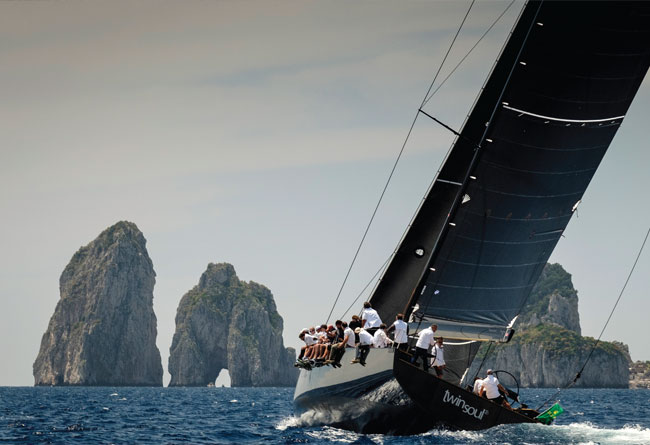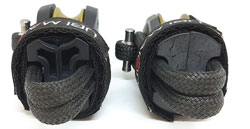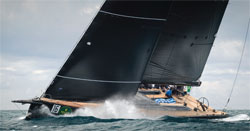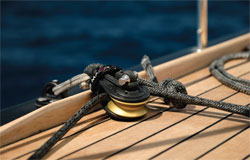

UBI Maior Italia supply some of the world’s most advanced custom hardware to the most demanding performance racers on the planet… looking back is not an option
Nearly everyone has heard of ‘3D printing’ or seen it in the movies: in some magical high-tech way, objects in three dimensions can be created directly from digital files with amazing accuracy. The users seem to effortlessly tap a few keys, the printing device hums and whirrs away, and “voilà”, an object appears that is ready to deploy.
The technology promises amazing results and has even resulted in controversy: for example, in the US, an advocate of guns rights has made available the digital files needed to produce an operable pistol that, when made of plastic, could be undetectable in most security scanners. Scary stuff.
But what is not scary and actually rather exciting is that the technicians at UBI Maior Italia have been working with this new technology – more properly termed AM (Additive Manufacturing) – in the realisation that soon metal removal would no longer be the only metalworking process done through a tool or head moving through a three-dimensional work envelope to transform a mass of raw material into a desired shape, layer by layer.
With AM technology, parts can now be made that fit unique niches in applications that would otherwise only be possible through more lengthy and traditional design and fabrication techniques. The possibilities are quite exciting, and UBI Maior is one of the first marine hardware fabricators to bring this from the realm of technological fantasy to reality.

As with most custom and semicustom manufacturing, projects at UBI Maior start with the customer and the concept. Listening is an important skill in the fabrication business, and once a problem is identified with the customer, a dialogue is established that clearly outlines the issues and the problems, the context of these issues, and then some brain-storming sessions to map out possible pathways towards a resolution of the problem.
Sometimes this process leads to using an existing part in production or perhaps one that can be easily modified for use to solve the problem. Regardless, this path often leads to fast and cost-effective resolutions because the high quality in the engineering of existing UBI Maior parts is already built in.
But when there is a unique need that can only be resolved through design and fabrication of new parts, this is where UBI Maior excels and is often asked to step in.
‘Our design team has several years of experience in using Computer-Aided Design (CAD) and Computer-Aided Manufacturing (CAM) tools, so the process of transforming ideas into three dimensions is well within our playbook,’ said UBI Maior project manager and engineer Vieri Abolaffio. ‘The added capability of having AM within our toolbox now both complements and enhances our existing CAD/CAM process. We can now be more efficient in building a prototype to examine, test, modify as needed and eventually produce in a reliable, safe and even cost-effective solution compared with traditional milling and assembly techniques.’
AM technology is not exactly new to the team at UBI Maior – they have actually been utilising its advantages for some time, but through an outside supplier. The demonstrated advantages, however, are now recognised to be strong enough that they have made the investment to take this fabrication, as well as design technology, in-house, which will further improve flexibilities and response times for their most demanding customers.
‘We have made the investment in both the extruder type of printer, in which we use a special grade of Nylon reinforced with continuous carbon fibre for its strength and stiffness, as well as the powder type of printer, which makes parts that are even stronger and more durable, and this is the direction for the future in AM technology,’ said Abolaffio.
‘With using both types, we also have the benefit of achieving much more accurate and acceptable finish surfaces on the final piece, which saves another step in the process.’
Besides optimising the design for structural integrity, this process allows clever aesthetic details as well, such as boat names embossed into the parts. For the styleconscious yacht owner and project manager, this is a great personalised touch that can transform a generic look to a spectacular custom look on deck.
The dimensions of what can be produced by the printer device at UBI Maior are large – 35cm x 27cm x 30cm – so this is not a novelty toy, but a serious machine capable of producing whole or constituent parts in nearly any application. And the benefits are impressive: for example, blocks made on this printer can be 20 per cent lighter but also have 20 per cent greater torsional stiffness due to more clever use of material in design and fabrication that is not achievable with a conventional machining approach.
And this can all be achieved at a speed that is normally never possible with conventional machining: from the design to the finished part can be as little as 24 hours. Imagine the relief felt by a team needing a part in this kind of rush and having UBI Maior there to help… this could be a lifesaver for any race programme. When a Wally superyacht team called up in a panic needing some fairleads, and with nothing in the inventory to meet their needs and no time to produce the necessary parts by conventional methods the team at UBI Maior met the challenge with their AM tools to produce new parts suited for the application and fabricated in titanium.
And the flexibility of AM fabrication means that even where a part cannot be produced in its entirety, but needs to be combined with another part to complete an assembly, the accuracy of the printed part often makes this process faster and smoother than trying to combine two machined parts.
‘For example, our first productionstatus application of this AM technology are our X3M blocks,’ said Abolaffio, ‘which have benefitted greatly in their design from it being possible to make hollow bodies, therefore enhancing the structural behaviour under torsional load yet still maintaining light weight.’

Above: the 80ft cruiser-racer Twin Soul B, designed and built by Mylius Yachts for the yard’s own president, is among the superyachts that have benefited from using UBI Maior’s 3D printing facilities to produce custom deck hardware on demand. However it’s not all about full-custom fabrication – UBI Maior’s first 3D printed off-the-shelf product line are these very light but strong new X3M blocks (below).

UBI Maior’s X3M blocks combine the attachment versatility of highstrength Dyneema with this clever body design to produce a wide range of solutions, from a 32mm sheave model that weighs only 58 grams and yet breaks at 3000kg, to a 120mm sheave model that weighs 1.74kg and breaks at 30,000kg. So X3M blocks are commonly found on a wide range of high-performance boats ranging in size from sportboats all the way up to superyachts.
Another example of where AM technology use in material and production methods has influenced superior design is in the evolution of UBI Maior furlers. These furlers have been favourites among the top race teams in a variety of competitive circuits for their reliability, light weight, and longevity in the tough and demanding environment of the active offshore racing foredeck.
‘The demand we place on our furlers is quite significant,’ said Abolaffio. ‘They are an active loadbearing member when our furling ratchet system is used, and they are often far out on the bow, attached to a heavy sail, and manhandled by bowmen, who are usually not known for their finesse and gentleness.’
These furlers are also abused even when not being loaded, such as when used with staysails or code zeros, since they get deployed in haste and then shoved into a bag or down a hatch when not needed.
‘By analysing the history of failures of our previous designs,’ said Abolaffio, ‘and otimising the shape of the final part using finite element method (FEM) calculations and automatic optimisation software, we have been able to take out material from the non-loaded parts of the design, and reinforce it where needed. We have therefore been able to make more complex shapes using curves in such a way that the whole structure behaves more like a spring than a rigid body during an impact, absorbing the hit without any permanent deformation or breakage. Developing and fabricating this shape would not have been possible using CNC milling machines or injection moulding.’
To fabricate this piece, UBI Maior uses a variety of high-performance Nylon called PA12 for the carter, the portion of the furler that handles the intake and exit of the furling line. PA12 is well-known in the plastics industry for its superior properties of high-impact strength, good weathering resistance, good resistance to chemicals, excellent abrasion and surface slip characteristics, minimum water uptake and good dimensional stability, low specific density, and excellent impact strength.
‘By using PA12 instead of Delrin, we achieve a 45 per cent increase in strength in this part,’ said Abolaffio, ‘and in the new FR87 furler, the weight has been reduced from 72 grams to only 58 grams due to the lower density. So overall we have increased both the strength and impact resistance of these components with use of this material fabricated in this way.’
3D printers and AM technology are just another way that UBI Maior stays ahead in offering clever engineering and innovative solutions to help its customers achieve their goals in performance.
Click here for more information on UBI Maior »
We invite you to read on and find out for yourself why Seahorse is the most highly-rated source in the world for anyone who is serious about their racing.
To read on simply SIGN up NOW
Take advantage of our very best subscription offer or order a single copy of this issue of Seahorse.
Online at:
www.seahorse.co.uk/shop and use the code TECH20
Or for iPad simply download the Seahorse App at the iTunes store


